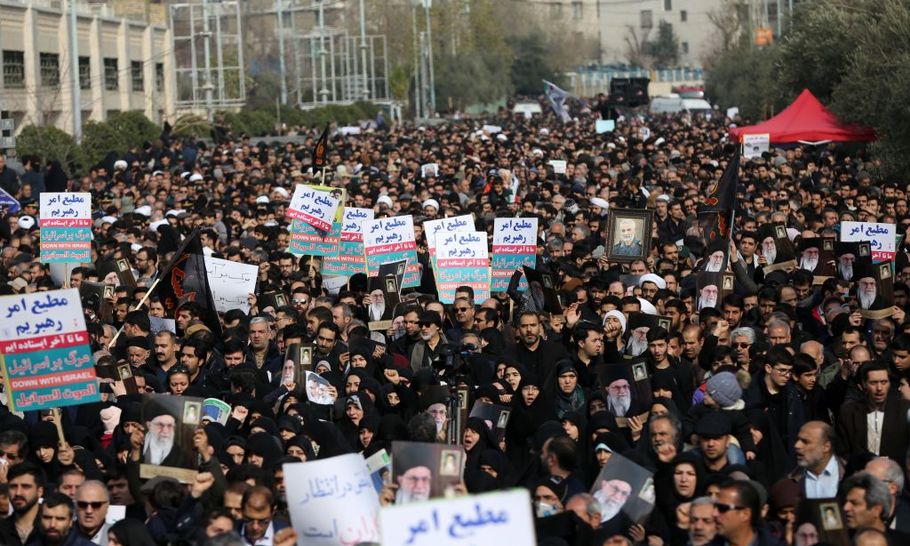A history of American killings

Tehran, Jan 3 2019: Protests at US airstrike (Fatemeh Bahrami/Anadolu Agency via Getty)
The Americans first used targeted killing as an act of war on April 18, 1943. Admiral Isoroku Yamamoto was a Harvard graduate, fluent English speaker and, after two tours of duty in Washington, a confirmed Americanophile; he was also the architect of the attack on Pearl Harbour. After US code-breakers had deciphered his itinerary of a tour of inspection of Japanese bases in the Pacific, a flight of P-38 Lightning intercepted Yamamoto’s aircraft and the accompanying escorts over Bougainville Island. A short dogfight ensued in which the admiral’s plane was shot down. His body was recovered the following day.
Following the same principle of decapitation, the first salvo of US missiles to hit Baghdad in the 2003 invasion were targeted at Saddam Hussein’s palaces in an attempt to kill him in the first engagement of the conflict. Subsequently, both Osama bin Laden and Abu Bakr al-Baghdadi have been killed in highly sophisticated and ruthlessly executed military operations. America, therefore, has some previous in the tactical application of targeted killing.
Initial reports of Soleimani’s assassination have been quick to draw parallels with bin Laden and al-Baghdadi, but they miss the point. The leaders of al Qaeda and ISIS were essentially cosmetic figures, neither of whom had shown much talent for the contact battle and whose main function was symbolic leadership. Yamamoto provides a far closer parallel to Soleimani in that he was his nation’s leading warfare practitioner and his death constituted both a material and a moral loss – a loss felt in inverse proportion to the grim satisfaction enjoyed by his US assailants. Even the tactical details of both operations are remarkably similar: highly specific intelligence leading to an aerial interdiction with limited collateral damage and no American losses – what in the trade is known as a force economy operation.
The one fundamental difference between the two operations is that Yamamoto was killed in circumstances where war had formally been declared between sovereign nation states, and Soleimani died in circumstances that defy formal definition, but have become known as hybrid warfare. The first is covered by the protocols of the Geneva Convention which specifically prohibits execution, unless preceded by formal legal process. The second has generated an animated legal debate that sees targeted killing as legitimate in circumstances of self-defence, a plea that has already been made today by US commentators.
But both are bound to have some basis in the theory of just war, first shaped by the thirteenth-century writing of St Thomas Aquinas and revised periodically ever since. A key concept in just war is proportionality and the principle that any single act should never result in disproportionate subsequent harm. Given the current temperature between Washington and Tehran, the potential consequences of the taking of a single life might seem to jeopardise this principle, and, while it is unlikely that President Trump will be detained by the musings of a pre-Renaissance Dominican friar, others will. And they are right to do so, because even the formless nature of contemporary warfare must have some boundaries based in morality and law; the alternative is the arbitrary and random rule of victor’s justice.
So much for historical precedent and moral reflection, but what happens next? I don’t have the first idea, and, despite broadsheet weekend editions that will be groaning with comment, neither does anyone else. I will, though, venture two observations – one from either side of what must now be a potential conflict.
Seen from within the Iranian Shia tradition, Qasem Soleimani could not have had a more gratifying death. From the battle of Karbala in 680 CE and the death of the Prophet’s grandson Huysein, the Shia strand of Islam has been dominated by a vocation for martyrdom and the doctrine of redemption through sacrifice. Anyone who has witnessed the passionate self-mutilation of the Shia faithful on the annual Day of Ashura will need no instruction on how central and pervasive martyrdom is to both the religion and the Iranian sense of their own history. Soleimani will be a loss to Iranian statecraft but has now moved beyond a corporeal existence to occupy a position of emblematic, perhaps spiritual, significance – what a way to go.
Also seen from Iran, the actions of President Trump must be profoundly confusing. Having abandoned the Kurds to their fate in northern Syria, apparently settled for a semi-detached position in the Middle East and habitually avoided real conflict, he pulls a stunt that that will have untold consequences for the entire region, and maybe beyond. Even the most adversarial and existential conflicts depend on an underlying assumption of rationality and the America of Kennedy, Kissinger and Powell would always want to be seen to operate within that boundary. Clearly President Trump does not see himself bound by such predictable conventions and it would be reassuring to think he is deriving subtle strategic advantage by manipulating his opponent’s expectations. Unfortunately, an equally likely explanation is that we are witnessing a display of juvenile petulance with no basis in rationality or strategy. In which case, all bets are off.





